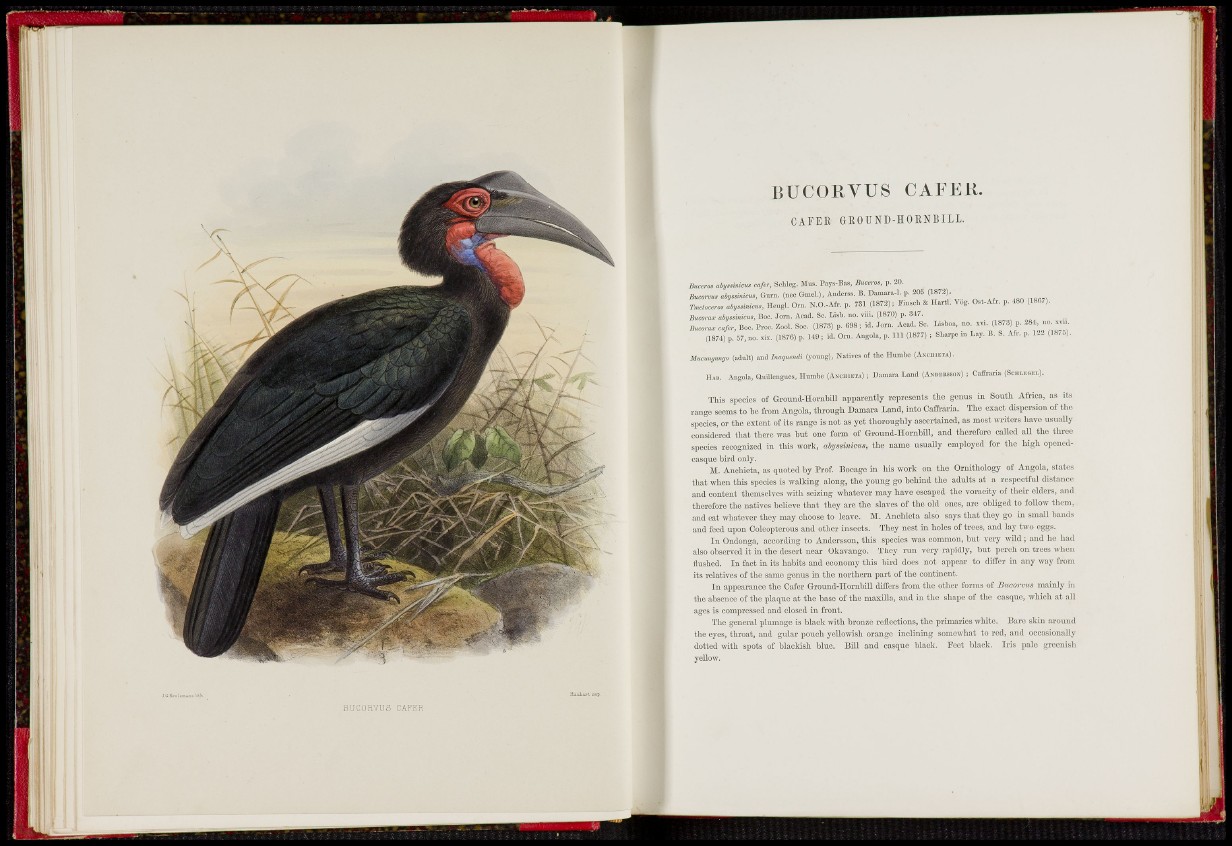
BUCORVUS CAFER.
CAFEE GEOUND-HOENBILL.
,< abttsimca aifir, Sohbg. Mu>. P.ys-Eio, Bucero,, p. 20.
ahvssinims Gurn. (ncc Gmel.}, Andem. B. Damara-1. p. 205 (1872).
o „ . ».LAf , . p. 731 „872,. Fins.h. n»«. y»^. o..-Af,, p. « 0 d», .
Biicom Boc. Jor». Acad. Sc. Li>b. no. Yiii. (I8?0) p. 347.
«/«•. Boc. Proc. Zool. Soc. (1873) p. 698, id. W . Acad. Sc. Li.toa, no d™ P'
(1871) p. 67, m. rix. (1876) p. 149; id. Orn. Angola, p. I l l (1877) , Sharpc m lay. E. S. Afr. p. 122 (18,o).
Mucwiguya (adult) and /»»}«e«ii (jonng), Natives rf the Humljc (Ancmm).
IL... Angola, Onillcngnes, Hnmlie (Aschiit..) ; Damai. Land (ANINI».»») ; Caftraria (Scm™»).
This spocics ot Ground-Uovnbill apparently represents the genas in South Africa, as its
range seems to be from Angola, through Damara Land, into Oaffrai-ia. The exact dispersion of the
spccics, or the extent of its range is not as yet thoroughly ascertained, as most writers have usually
considered that there was but one form of Ground-Hornbill, and therefore called all the three
species recognized in this work, aiyssmicm, the name usually employed for the high openedcasque
bird only.
M. Anchicta, as quoted by Prof. Boeage in his work on the Ornithology of Angola, states
that when this species is walking along, the young go behind the adults at a rospectful distance
and content themsclTCS with seizing whatever may have eseapcd the voracity of their elders, and
therefore the natives believe that they are the slaves of the old ones, are obliged to follow them,
and eat whatever they may choose to leave. M. Anchicta also says that they go in small bands
and teed upon Coleopterous and other insects. They nest in holes of trees, and lay two eggs.
In Ondonga, according to Andcrsson, this species was common, but vei-y wild; and he had
also observed it in the desert near Okavango. They run very rapidly, but perch on trees when
flushed. In fact in its habits and economy this bird docs not appear to differ in any way from
its relatives of the same genus in the northern part of the continent.
In appearance the Oafer Ground-Hornbill differs from the other forms of Bucm-ms mainly in
the absence of the plaque at the base of the maxilla, and in the shape of the casque, which at all
ages is compressed and closed in front.
The general plumage is black with bronze reflections, the primaries white. Bare skin around
the eyes, throat, and gular pouch yellowish orange inclining somewhat to red, and occasionally
dotted with spots of blackish blue. Bill and casque black. Feet black. Iris pale greenish
yellow.
B U C O R V U S CAPER